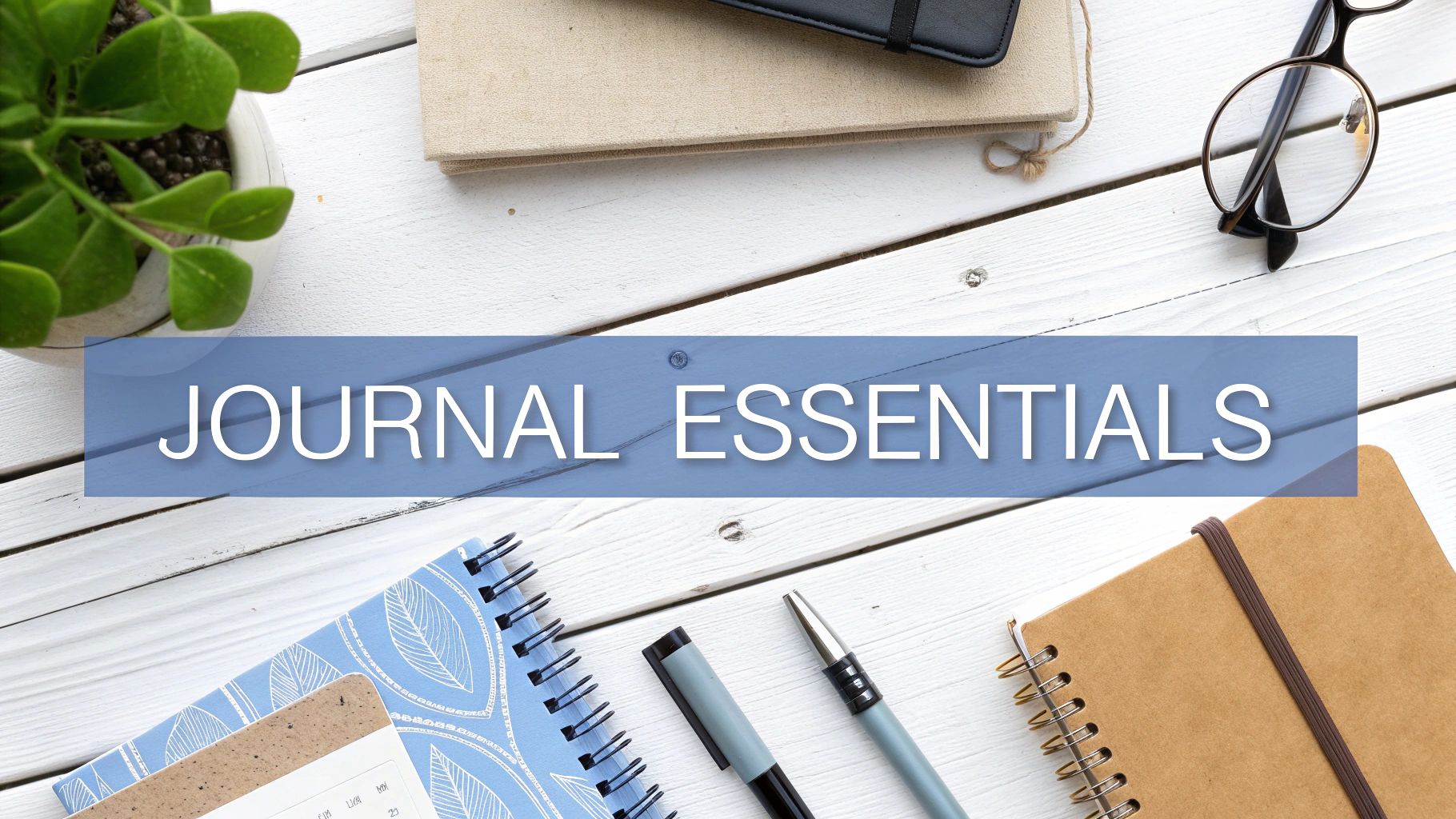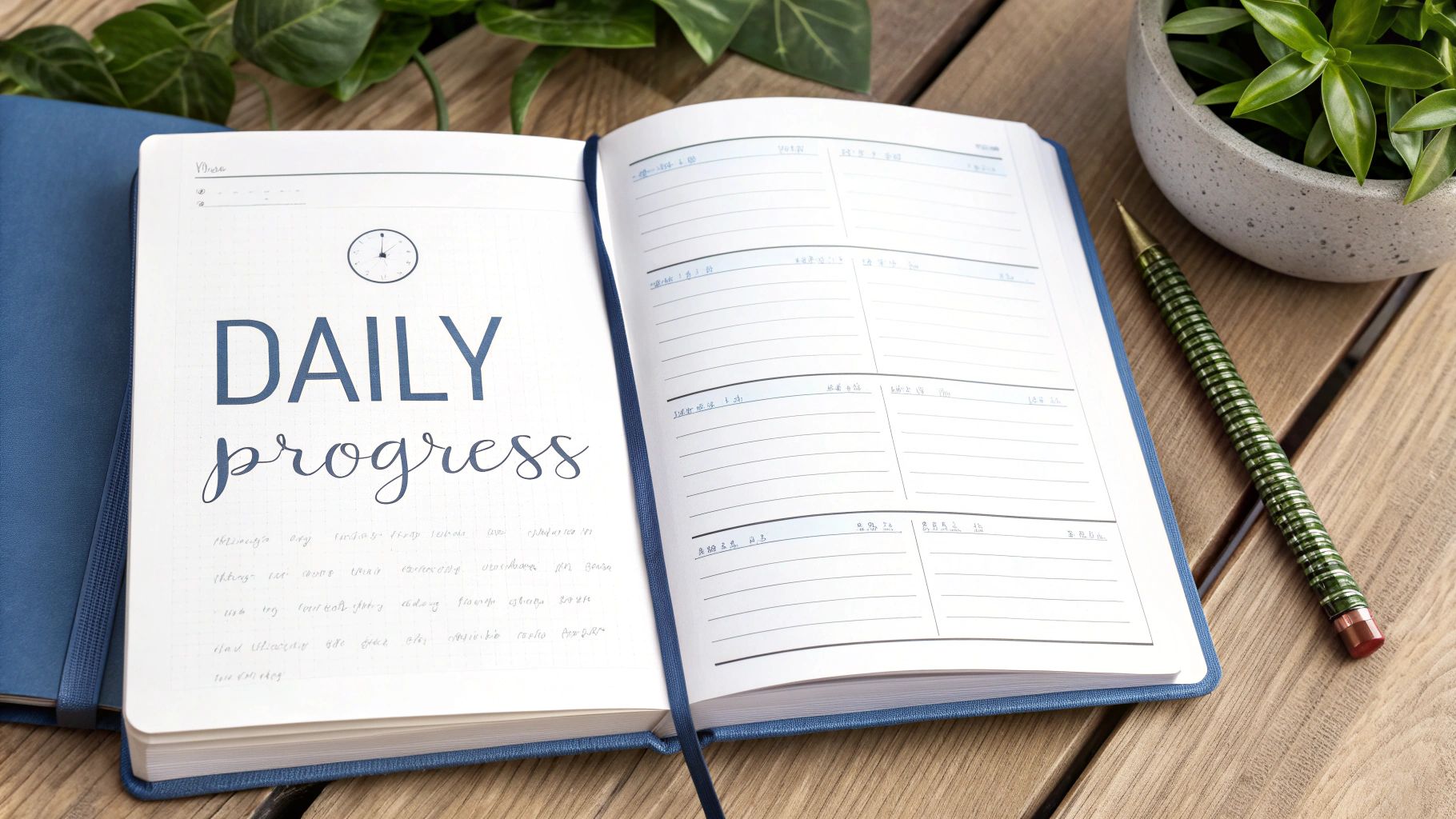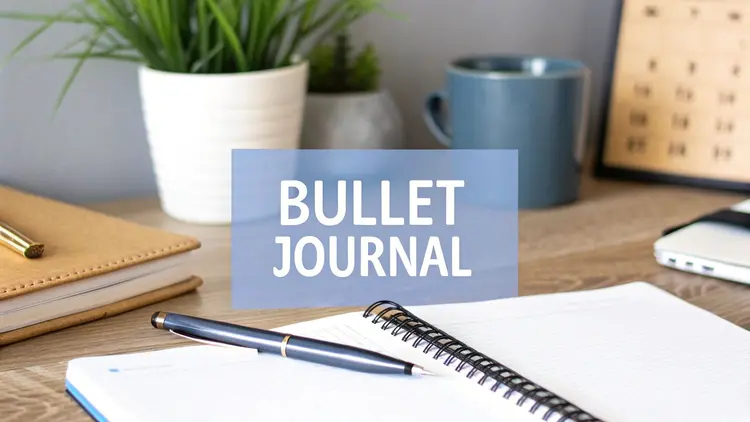The world of organization is constantly changing.
New systems and methods always appear, promising to make our lives more productive. But amidst all this change, bullet journaling has become a popular and lasting approach. Created by Ryder Carroll in 2013, this analog system is thriving, even in our digital age. It appeals to both productivity fans and creative people.
This unique approach combines practical task management with reflective journaling. It’s not just about checking off to-dos. It’s about understanding how you work, prioritizing tasks effectively, and connecting with your goals on a deeper level.
The magic lies in its simple dot-grid pages.
They provide a completely customizable framework that adapts to your own way of thinking.
This flexibility is a big reason why it’s so popular. It lets you personalize your journal and change it over time. Traditional planners often have a rigid structure, with little room for personal touches or changing needs. Bullet journaling, however, lets you create a system that truly works for you.

By 2020, the Bullet Journal community had grown to over 4 million Instagram users. The hashtag #bulletjournal had over 7 billion views. As of 2023, the community keeps growing, with new users discovering its benefits every day. Want to see more stats? Check out this helpful guide: How to Start a Bullet Journal for Beginners.
The Power of Customization
The real strength of bullet journaling isn’t about creating perfect Instagram posts. It’s about creating a system that grows and changes with you. This personal approach makes you feel more connected to your journal and encourages you to use it regularly.
Whether you like detailed trackers or simple daily logs, it’s about finding what works best for your thinking style. This focus on personalization is what makes bullet journaling different from other, more rigid planning methods. It encourages you to experiment, adapt, and create a system that reflects how you think. This is why it’s more than just a planner; it’s a tool for self-discovery and personal growth.
You can find more helpful tips here: Bullet Journal for Beginners: Start Your Creative Journey.
The Only Supplies You Actually Need to Start

Starting a bullet journal doesn’t have to break the bank. Surprisingly, you only need a few basic supplies to get started. This simplicity helps avoid what some call “supply perfectionism,” which can be a real roadblock for beginners. It’s easy to get caught up in the gorgeous bullet journal spreads you see online, but that can lead to feeling overwhelmed before you even begin.
The Core Essentials
To start bullet journaling, you absolutely need only two things: a notebook and a pen. Choosing these wisely, though, can make a big difference in how much you enjoy the process. Don’t worry, this doesn’t mean buying the most expensive items. It just means finding tools that work best for you and your writing style.
- Notebook: We highly recommend a dot-grid notebook. The dots provide a helpful guide for keeping things neat without the restrictions of lined or grid paper. Dot-grid notebooks offer the flexibility to create custom layouts, trackers, and collections.
- Pen: Pick a pen that feels comfortable in your hand and writes smoothly. Experiment with different pen types on dot-grid paper to find your perfect match. Popular options include gel pens, ballpoint pens, and fineliners.
You probably already have these basic supplies on hand, so you can start your bullet journal right away! Trying out different notebook and pen options, however, can enhance your experience and help you stick with it.
Helpful Additions (But Not Essential)
While a notebook and pen are enough to get started, a few extra tools can enhance your journaling. These aren’t essential, but they can add some helpful functionality and make bullet journaling even more enjoyable.
- Highlighters: These are great for emphasizing important tasks, deadlines, or special events in your journal.
- Ruler: A ruler helps create perfectly straight lines when setting up layouts, trackers, or just dividing sections in your journal.
- Colored Pens: Using colored pens can help visually categorize different entries or add a pop of personality and creativity.
These additions can make your bullet journal visually appealing and easy to navigate. But remember, the heart of bullet journaling is functionality and personalization, not fancy decorations. Check out our guide on Everything About the Bullet Journal for more helpful tips.
To help you get started, we’ve put together a handy comparison of essential and optional supplies:
Bullet Journal Supplies Comparison
This table compares essential and optional supplies for beginners, showing cost ranges and importance ratings.
| Supply Type | Necessity Level | Cost Range | Beginner Recommendation |
|---|---|---|---|
| Dot-grid Notebook | Essential | $5 – $30 | Highly Recommended |
| Pen (Gel, Ballpoint, Fineliner) | Essential | $1 – $10 | Choose a comfortable pen that writes smoothly |
| Highlighters | Optional | $2 – $15 | Helpful for emphasis |
| Ruler | Optional | $1 – $5 | Useful for straight lines |
| Colored Pens | Optional | $3 – $20 | Adds visual interest |
As you can see, the essential supplies are quite affordable. The optional supplies can enhance your experience, but they’re not required, especially when you’re first starting out.
Avoiding the Comparison Trap
It’s easy to fall into the trap of comparing your bullet journal to the picture-perfect spreads you see online. While those can be inspiring, remember that they often don’t reflect the reality of everyday journaling. Many experienced bullet journalists will tell you that the most effective journals are often the simplest. Highly decorated spreads can also be time-consuming, leading to burnout and inconsistency.
Instead of aiming for perfection, focus on building a system that works for you. Start with the basics and gradually experiment with different layouts and techniques as you go. This personalized approach is much more sustainable and beneficial than trying to copy complicated designs. Remember, the true power of bullet journaling lies in its ability to adapt to your individual needs and preferences. Don’t let “supply perfectionism” hold you back!
First Pages That Won’t Intimidate You

That new notebook can feel a little daunting, right? Those crisp, empty pages might seem to demand perfect calligraphy and intricate drawings. But when you’re just starting out with bullet journaling, it’s all about practicality, not artistic flair. This section will help you overcome that initial hesitation and build a solid framework for your bullet journaling adventure.
Taming the Index
The Index acts like a personal GPS for your bullet journal. It keeps tabs on everything you add, so you can easily locate information later. Think of it as your journal’s table of contents. Begin by numbering your pages. Then, as you create different sections, simply list them in the index alongside their corresponding page numbers. This easy step will prevent a lot of frantic searching down the line.
Looking Ahead: The Future Log
Your Future Log is where you’ll jot down long-term plans and upcoming events. It offers a high-level overview of what’s on the horizon in the coming months. A simple way to set this up is to use a two-page spread, dividing it into sections for each month. Here, you can note important dates, deadlines, or anything you want to remember. For instance, if you have a conference scheduled in six months, make a note of it in that month’s section.
Monthly Spreads: Finding Your Rhythm
Monthly spreads offer a way to plan and track your progress throughout the month. A popular layout is a calendar view on one page and a task list on the facing page. This gives you a visual overview of your month, alongside a dedicated space for your to-dos. If you’re looking for more ideas, you might find this helpful: How to master bullet journaling with page-by-page guidance. Don’t be afraid to play around with different monthly spread layouts until you find what clicks for you.
Rapid Logging: Your Secret Weapon
Rapid logging is at the heart of the bullet journal system. It uses simple symbols, called signifiers, to categorize your entries.
A dot (•) indicates a task, a dash (-) signifies a note, and a circle (o) marks an event.
So, for example, “• Grocery shopping” is a task, “- Remember to call the vet” is a note, and “o Dentist appointment” is an event. As you get more comfortable, feel free to personalize your signifiers to fit your needs.
Overcoming Perfectionism
Bullet journaling appeals to a wide range of people, especially young adults looking for better organization. Around 70% of bullet journalists are between 18 and 34, with 60% using their journals daily. This high usage rate shows its effectiveness as a productivity tool. Find more detailed statistics here. However, many beginners get caught up in the pursuit of perfection. Remember, your bullet journal is a personal tool. It doesn’t need to be flawless. Focus on making it functional, not aesthetically perfect. Start simple and gradually add details as you gain confidence.
Troubleshooting Common Mistakes
A common pitfall for beginners is trying to replicate the elaborate spreads they find online. This can be discouraging. Instead, concentrate on building a system that works for you. Begin with basic layouts and personalize them gradually. Another frequent mistake is overcomplicating the system. Keep things simple, especially when you’re starting out. The key is to strike a balance between practicality and creativity. Building a successful bullet journal takes time and experimentation. Don’t hesitate to try new things and adapt your approach as you go.
Beginner-Friendly Layouts That Actually Work

Let’s face it: those incredibly artistic and complex bullet journal spreads you see online can be a bit intimidating for beginners. The good news is that you don’t need to be an artist to have a successful bullet journal! This section focuses on practical and easy-to-maintain layouts perfect for anyone just starting out. By exploring a variety of beginner journals, we’ve identified five core layouts that offer a big impact without needing advanced artistic skills. These layouts will help build a solid foundation for your bullet journaling journey.
Streamlined Habit Trackers
Habit trackers are a visual way to see your daily habits and track your progress. They also help you identify areas where you might want to improve. A simple grid layout is the most effective way to create a habit tracker. List your habits down the side and the days of the month across the top. Each time you successfully complete a habit, simply fill in the corresponding box. Seeing your progress visually like this can be incredibly motivating! Want more habit tracker inspiration? Check out these 8 Effective Habit Tracker Bullet Journal Layouts for Building Better Habits.
Simple Mood Monitoring Systems
Keeping track of your moods can be a great way to understand your emotional well-being over time. Mood trackers allow you to do just that! A simple key using colors or symbols can represent different moods. Each day, mark your primary mood in your tracker. As you track your moods over time, you might start to notice patterns and triggers related to your emotional state. This increased self-awareness can be a valuable tool for personal growth.
Weekly Plans That Adapt
Weekly spreads give you a quick overview of your week ahead, and it’s important for them to be flexible and adapt to your changing schedule. A simple vertical layout with each day of the week listed works really well. This allows you to jot down appointments, tasks, and any other important events for each day.
Achievable Goal Frameworks
Goal setting is a key part of bullet journaling. Breaking down larger goals into smaller, more manageable steps can make them seem much less overwhelming. Use a dedicated page to outline your goals and the steps you need to take to achieve them. As you make progress, track it on the page and be sure to celebrate your successes!
Focused Collection Pages
Collection pages are dedicated to specific topics or projects you’re interested in. They can be for anything from books you want to read to travel plans you’re making. Start a new page for each collection. This will keep your journal organized and make it super easy to find information related to a specific subject.
Practical Tips for Success
Don’t feel pressured to create complex spreads right away. Start simple! It’s also a good idea to plan your layouts before you start writing or drawing in your journal. This will help prevent mistakes and ensure you make the most of your journal’s space. And finally, remember that consistency is key. Even just a few minutes of journaling each day can have a big impact!
Beginner-Friendly Bullet Journal Layouts
This table summarizes different layout types with their purposes, complexity levels, and time requirements:
| Layout Type | Purpose | Setup Time | Complexity Level | Maintenance Needed |
|---|---|---|---|---|
| Habit Tracker | Monitor Habits | Low | Low | Daily |
| Mood Tracker | Track Moods | Low | Low | Daily |
| Weekly Spread | Plan Weekly Schedule | Low | Low | Weekly |
| Goal Framework | Set and Track Goals | Medium | Low | Weekly/Monthly |
| Collection Pages | Organize Information | Low | Low | As Needed |
These simple but effective layouts can help you create a bullet journal that’s both functional and enjoyable to use. This will set you up for a positive and successful bullet journaling experience. And remember, don’t be afraid to experiment as you continue your bullet journaling journey. Find what works best for you!
Building the Bullet Journal Habit That Sticks
So, you’ve got your bullet journal all set up, it’s filled with gorgeous layouts, and you’re ready to take on the world. But then, well, life happens. Work deadlines start piling up, your social calendar gets packed, and suddenly, that beautiful journal sits untouched for days, then weeks. The real magic of bullet journaling lies in staying consistent, especially when you’re just starting out.

Integrating Journaling Into Your Routine
The best way to create a new habit is to link it with one you already have. Think about your daily routine. Do you have a morning coffee ritual? A relaxing way to wind down in the evening? Find a consistent time, even just 5-10 minutes, where you can easily fit in some journaling. For example, you could review your bullet journal with your morning coffee, or plan your next day before bed. This creates a natural connection and makes journaling feel less like a chore.
The Power of Environmental Triggers
Our surroundings play a big part in shaping our habits. Create visual cues to remind you to journal. Leave your journal open on your desk, put it next to your bed, or keep your favorite pen where you can see it. These small environmental nudges act as reminders, gently encouraging you to journal throughout the day. You might be interested in: Can bullet journaling save your day?
Overcoming Lapses and Maintaining Momentum
Life throws curveballs, and there will be times you miss a day, or even a week, of journaling. The trick is to avoid the “all-or-nothing” trap. Don’t get down on yourself about missed entries. Just acknowledge the lapse and pick up where you left off. Remember, consistency is about the big picture, not unrealistic perfection. Bullet journaling has shown positive effects on both productivity and mental health. By offering a structured yet flexible system for managing tasks, it helps users stay organized and focused. The reflective element of journaling can also reduce stress. Learn more about the impact of bullet journaling.
Finding Your Optimal Journaling Window
Everyone’s different. Understanding your chronotype, your natural sleep-wake cycle, can help you find the best time for journaling. Are you a morning person, full of energy at sunrise? Or does your creativity peak in the quiet of the evening? Experiment with different times to see what fits your energy levels and lifestyle.
Pushing Through the Motivation Dip
The initial excitement of a new journal can fade. This is totally normal. Expect this dip in motivation and have strategies ready to combat it. Connect with other bullet journalers online or in person for inspiration and encouragement. Remind yourself of the benefits you’ve gained from journaling, like increased productivity or a better mood. Celebrate your small victories and focus on your progress to keep the momentum going and build a sustainable habit.
Surviving the First Month: Mistakes and Mindset Shifts
The first 30 days of bullet journaling are a make-or-break period. Will your journal become a treasured companion or just another dusty notebook? Many beginners stumble over psychological hurdles early on. Let’s explore these common challenges and how to conquer them.
The Comparison Trap
It’s easy to fall into the comparison trap. Scrolling through Instagram or Pinterest, you’re bombarded with picture-perfect bullet journal spreads. It can make you feel inadequate. Remember, social media shows the highlights, not the messy reality. Your journal is a personal tool, not a competition. Prioritize function over fancy looks, especially when starting out.
Embracing Imperfection: Mistakes Happen
Don’t freak out over smudges, crooked lines, or less-than-perfect layouts. Mistakes are inevitable. See them as learning opportunities. Instead of chasing an impossible ideal, build a system that actually works for you. Experiment with layouts, pens, and signifiers. Find what clicks. Your journal will evolve over time to reflect your individual style and needs.
Shifting Your Mindset: Progress Over Perfection
Perfectionism is the enemy of progress. It can paralyze you and steal the joy of journaling. Bullet journaling is about moving forward, not achieving flawlessness. Celebrate small wins, like journaling consistently for a week or finishing a habit tracker. Focus on your progress, no matter how small, to stay motivated.
Learning From Others: Stories of Resilience
Hearing other people’s journaling journeys can be incredibly encouraging. Many experienced bullet journalists have stories of initial struggles and eventual success. For example, some journalers recommend trying indexing even if you end up abandoning it later. These experiences highlight the importance of adapting and finding what truly works for you. Building a successful bullet journal is a marathon, not a sprint.
Maintaining Motivation: Beyond the Initial Excitement
It’s normal for that initial burst of enthusiasm to fade. To reignite your motivation, connect with other bullet journalers. Sharing tips, layouts, and experiences creates a sense of community. Also, regularly review your journal. Reflecting on how it has helped you achieve your goals reminds you of its value. This self-reflection also helps you fine-tune your system.
Recovery Plans: Getting Back on Track
Life happens. You might miss a few days, or even weeks, of journaling. Don’t beat yourself up! Just acknowledge the break and pick up where you left off. Create a recovery plan by reviewing your tasks and goals, migrating unfinished items, and tweaking your layouts. Avoid the “all-or-nothing” trap and embrace the flexibility of bullet journaling.

Lorelei has been an online entrepreneur, marketer and writer since 2006. Her biggest passion is WordPress, which is why she switched to being a full-time blogger 20 years ago and hasn’t looked back since. With so many years of experience behind her, she is an expert in copywriting, SEO, marketing and business strategies.






